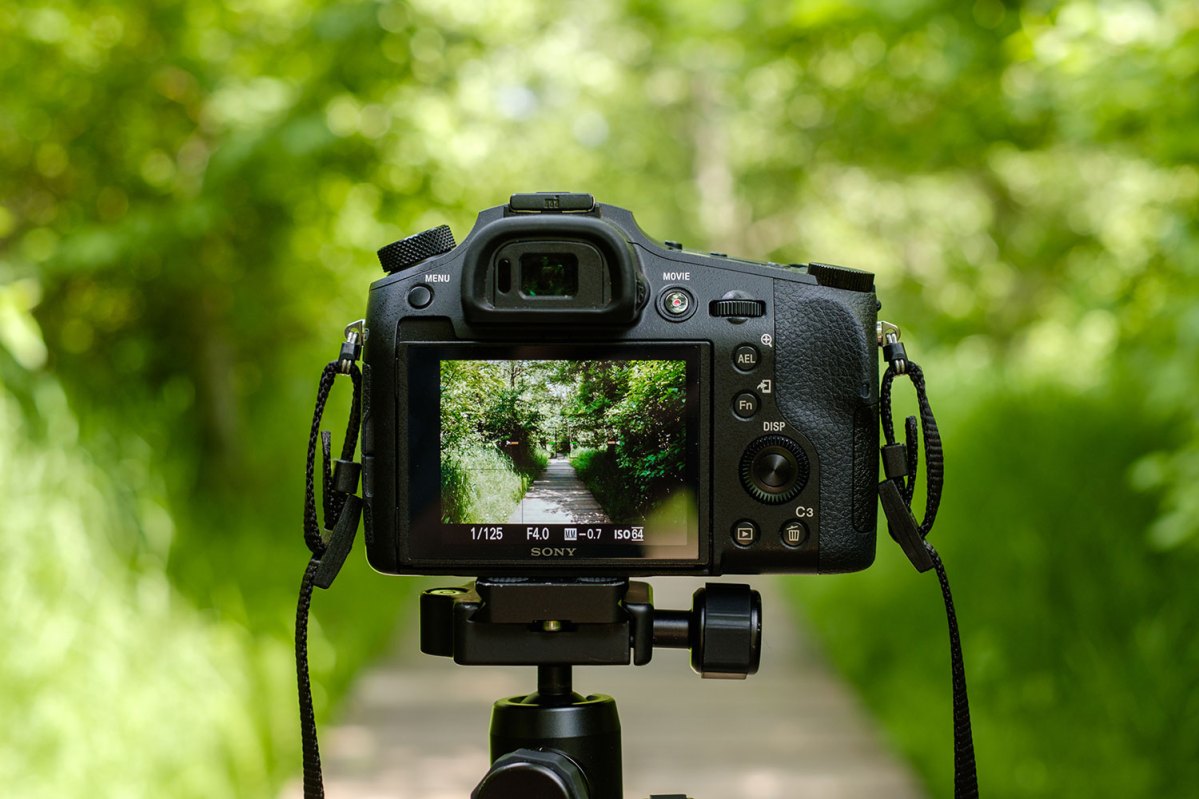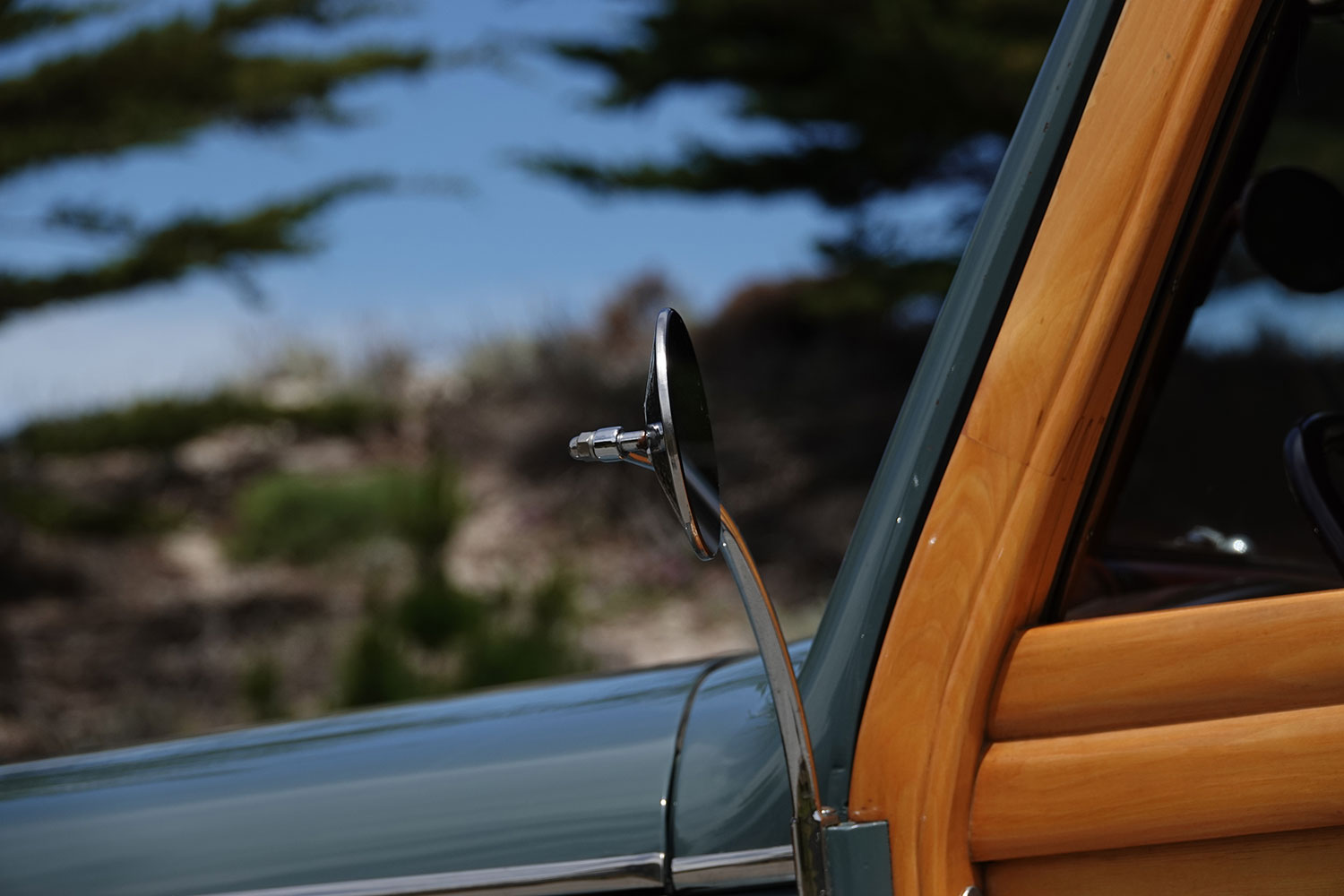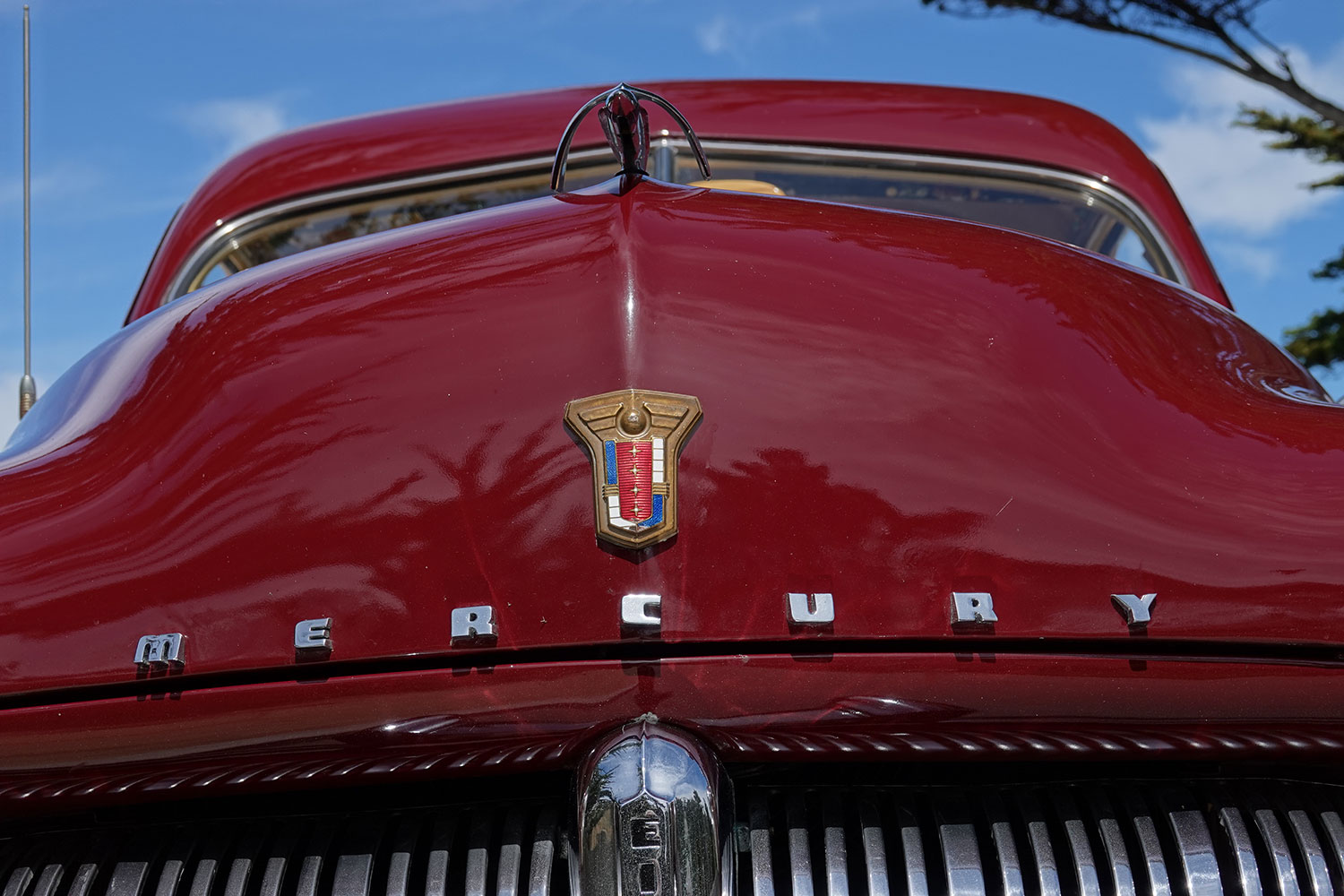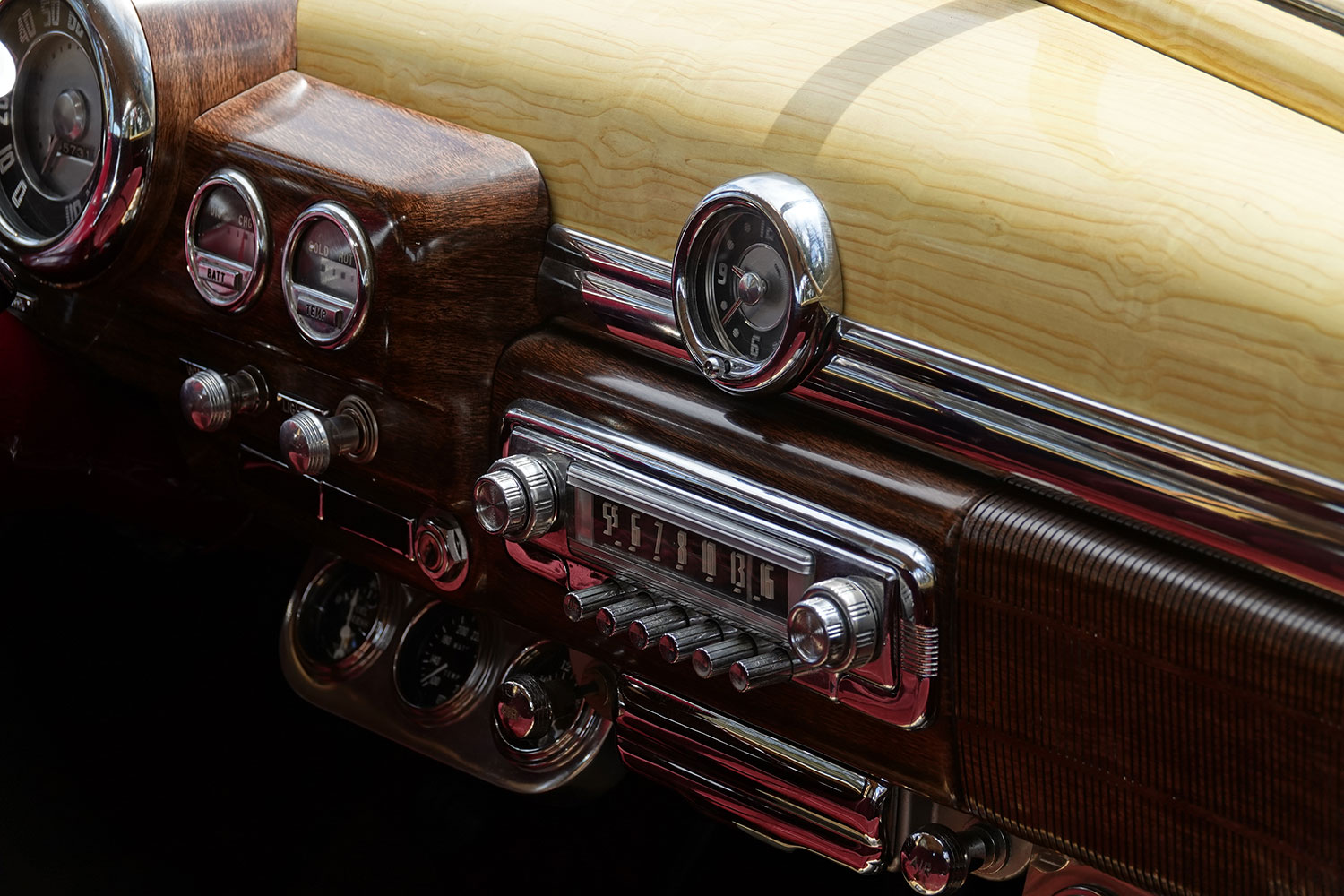What Year Did Sony Introduce Cyber Shot Camera
Sony Cyber-shot RX10 IV
MSRP $1,699.99
"Sony's Cyber-shot RX10 Four volition make yous a believer in all-in-1 cameras."
Pros
- Very high-quality stills and movies
- 25x telephoto Zeiss lens
- Heart AF role is outstanding
- Features designed for amateur filmmaking
- i-inch stacked sensor
Cons
- Tends to overexpose in car way
- Sony's menus are still hard to navigate
There is a segment of photographers who desire the operation of an interchangeable lens camera, but could do without the majority from having to carry a torso and lens. For that reason, "bridge" cameras were created. They provide DSLR-similar attributes, such every bit different shooting modes and longer lenses than compact cameras, but in all-in-one bodies that are smaller than DSLRs. The problem with many of these bridge cameras is that they use the aforementioned technologies found in point-and-shoots, and so you weren't getting whatever improvements in image quality or operation.
Sony changed all that with the advanced RX10-series. Built around a 1-inch sensor and high-quality Zeiss lens, the RX10 has the look and feel of a DSLR, but in a robust all-in-one body that'southward weather-sealed. While we wouldn't compare RX10 models to enthusiast or professional person-level DSLR and mirrorless cameras, they aren't far behind. The latest and all-time example yet is the Sony Cyber-shot RX10 Mark 4. A follow-up to the already peachy RX10 Mark Three, the RX10 4 has a 25x zoom and Sony'south latest 1-inch "stacked" sensor, but improves upon its predecessor with very fast functioning. Admittedly, the $1,700 price tag is tough to swallow, merely to become a comparable outfit from a DSLR or mirrorless, you would accept to spend much more coin.
Unlike other cameras we've reviewed, we've had an opportunity to spend a lot of time playing with the RX10 4. With such a loftier request toll, nosotros wanted to make certain this is worth your investment. Information technology isn't a camera for everybody, but for the right audition, it ticks all the boxes. If you think bridge cameras tin't match higher-end cameras, the RX10 4 will change your heed.
Familiar blueprint, stronger performance
Beyond Sony'south RX10 lineup, the RX10 Iv has undergone fiddling in the way of external design changes since the original was released in 2013 (all models are currently for sale). All four RX10 models are bridge cameras with a ane-inch sensor and a stock-still, high-quality Zeiss Vario-Sonnar T optical lens, merely each offers different features and performance. And, while all-in-one bridge cameras have targeted coincidental photographers, the RX10 steers toward more advanced users — a fact indicated by its high price.
The original RX10 had an 8.3x zoom with a range of 24-200mm and a abiding discontinuity of f/2.8 that'south terrific for blurred backgrounds throughout the unabridged focal length. The much bigger and bulkier RX10 IV has a 25x zoom (24-600mm) which is extremely useful for zeroing in on faraway subjects. For that extra altitude, you take to give up the constant f/two.8 aperture, just f/iv at 600mm is nevertheless pretty skilful.
The RX10 IV uses a 20.ane-megapixel Exmor RS sensor and a Bionz X image processor. The 1-inch sensor uses Sony's "stacked" technology that's designed to deliver faster performance than a typical sensor, also as features like super-slow-motion. We've had a lot of experience using Sony cameras with stacked sensors, and they all deliver solid performance.
The RX10 IV is most identical to the RX10 Three, just much faster.
On paper, the RX10 IV'due south specs wait like a well-nigh-facsimile of the RX10 III, only what the $300 premium gets y'all is faster operation. Sony told us that the Bionz X in the RX10 Iv is actually a newly adult processor, and, working with the stacked sensor, it can achieve a continuous shooting speed as high as 24 frames per second (fps) and an autofocus speed of 0.03 seconds. The RX10 III can shoot upwards to 14 fps.
Another plus is an autofocus system that uses 315 phase detection AF points and 25 contrast discover points that cover near the entire sensor. Shutter lag is really a matter of the past and yous can capture super-fast action. Couple it with an electronic shutter speed of i/32,000th of second and there isn't much you can't catch.
The camera measures 5.25 x 3.75 x 5.ane inches and weighs approximately 2.4 pounds (39 ounces) with battery and menu, which is a chip heavier than a Canon EOS Insubordinate T7i DSLR with a kit lens fastened. Information technology's xi ounces heavier than the original RX10 equally well, simply remember that you're getting a higher-quality lens with a long focal range.

And speaking of the lens, the non-removable 25x zoom dominates the front. It'due south a Zeiss Vario-Sonnar T* lens with 18 elements in 13 groups. Besides the focus and zoom rings, there's an aperture ring for when you're in Discontinuity Priority mode. A switch lets you change focusing altitude to either full, or 3 meters to infinity, but the feature is only constructive at 150mm or greater; it'due south in total manner otherwise. A Focus Agree button is also nearby, which lets you lock focus, merely you can as well customize it for another function.
On the front end in that location is also a focus control dial, which lets you select either single, continuous, auto, direct manual focus (DMF) and transmission focus (MF). During our tests we kept information technology primarily in automobile, as it switches automatically betwixt single and continuous.
The autofocus organisation uses 315 stage detection and 25 contrast notice points that comprehend almost the entire sensor.
Likewise having a DSLR-like body, the RX10 4 has a modest monochrome LCD on the top that shows current settings. This is a feature found in higher-end interchangeable lens cameras, which, again, points to the type of user Sony has in listen. That's not to say casual users or newbie photographers can't use this photographic camera, as there are plenty of automated functions.
The rear is dominated by a tilting 3-inch LCD that'southward rated i.44-million pixels. It has some touch capability as well (more on this later), but we have definitely seen better displays. What we practice like is the very high-quality 0.39-inch OLED electronic viewfinder with ii.359-million dots. It's is very expert, which is important since you'll be property the camera to your heart nearly times, given the need for stability with a 600mm zoom.
On the correct side is a card slot while the left doors cover connections for a mic, headphone, HDMI-out port and AV-in port for charging the battery in-camera. Since the RX10 IV is also marketed as a video camera, these ports are ideal.

As for battery life the maximum number of shots is 400, which is enough for a day's shooting merely still a fraction of what an enthusiast DSLR can muster — two or three times as much. The RX10 IV supports high-speed SDXC carte, and we recommend you lot use i if you plan to employ the avant-garde shooting modes or 4K video.
Like near modern cameras, you lot can pair the RX10 IV with a smartphone, and apply the PlayMemories Mobile app for remote control, or transfer photos for uploading to Instagram or wherever y'all do your sharing. You can too add location information. It'south zero special to brag about, but it works. Sony as well provides Capture 1 and Imaging Edge software for processing and editing RAW images.
Performance and use
We've tested the RX10 IV in multiple occasions, almost recently for several weeks capturing the scenery and scenes in Sedona, Arizona and Monterey, California. (Editors' note: Sony provided us with some of the testing opportunities as role of media events.) For an almost iii-pound camera, information technology was fairly comfortable walking around with it. When the lens is extended all the way, it looks a bit ridiculous simply a little embarrassment isn't so bad when you can photograph faraway subjects such as wildlife or mountain tops.
Portraits shot with Eye AF part are simply out of this world.
The 600mm zoom is a boon for wild animals photographers, however, a monopod should be part of your setup. Even though the lens has congenital-in optical image stabilization it isn't a phenomenon worker at 25x zoom since every jiggle of handheld shooting can bear on the epitome or video. We got loads of keepers just we recommend using some sort of back up.
I of our favorite RX10 features is Centre AF. You frame your subject with face detection enabled, then press the center OK primal on the back. A pocket-sized box appears on the person'due south center; the camera does the rest when you lot printing shutter. What you finish up with are portraits that are simply out of this earth, with detail and then fine you can count eyelashes. Although many rave about other Sony features, Eye AF ranks up there for day-to-twenty-four hours shooting. Dynamic Range Optimization (DRO) is another good but buried characteristic: Make adjustments (level i-v) and you tin can bring particular out of the shadows. Nosotros advise users experiment with these two features.
1 of ten
The RX10 IV isn't merely for withal photography. It'due south the start Cyber-shot model to use Sony'south Loftier-Density Tracking AF technology, which maintains focus around your intended subject, thanks to those 315 focus points. This is ideal for sports or anything that moves, and it's unremarkably something yous encounter in higher-end cameras.
In most instances we shot aperture priority with the single shot setting. In others, such every bit surfers, we shot 24 fps bursts. The RX10 Iv has a mechanical shutter speed of 30-1/two,000th of a second but an electronic shutter hits 1/32,000th. With the proper technique you can capture practically anything that moves. The 24 fps tin can be lowered to slower options as you drill down into the menus. Although we've used Sony cameras for years, the menu organisation is still dense and we hope it's revamped in the futurity. We've been request for years, and then wishful thinking, merely we are not alone with this complaint — Sony keeps proverb they are listening but simply time will tell.
Some other complaint is the photographic camera's tendency to overexpose in machine style. The EVF will alert you to the fact and a quick exposure bounty aligning (typically two-thirds of a stop) got us to where we wanted to be. (Or, don't be in car style and play effectually with the settings.)

The RX10 Four has an ISO range of 100-12,800 in machine mode just tin exist extended to 64 and 25,600. The photographic camera is solid to 2,500 ISO, but then tends to soften a scrap every bit you heave the sensitivity. Nevertheless, 12,800 was useable, which is pretty incredible for a 1-inch sensor. For maximum overall sharpness, we'd attempt to go on it below 2,000, but in low-light situations, you tin can definitely creepo it upwardly a trivial higher and still go decent results.
Peel tones were right on the money, skies had the right shades of blue, greens were rich.
The camera shoots 4K video and nosotros had a ball recording everything from surfers to live rock bands. Again, despite onboard epitome stabilization, yous need proper support to eliminate shake, which is accentuated by the high resolution. In addition to Full Hard disk drive 1080p, yous tin too record High Frame Rate (HFR) clips, also known as deadening-motion. When capturing a soccer thespian, at 960 fps, nosotros could see his graceful motion in kicking the ball — layer some beautiful instrumental music in post-edit, and y'all have yourself an elegant sports movie. When used judiciously this is a fun, creative tool. Merely note that you should employ a loftier-speed SDXC card.
As with the previous RX10, overall paradigm quality is quite proficient and highly-seasoned. Pare tones were right on the money, skies had the right shades of blue, greens were rich; the ane-inch sensor delivered authentic colors that will make nearly shutterbugs happy with the stop results.
Shooting 4K videos with the RX10 is a nail although we did tend to become a little zoom crazy, but if yous have a 25x lens it's hard not to. But exist sure to accept a tripod for support in extreme telephoto as every jiggle shows up on the big screen. We found piffling evidence of rolling shutter in our videos. Color accuracy — but every bit in most instances of the stills — was on target, with solid results. For those who desire to beyond the capabilities of the camera there are mic and headphone inputs for added accessories.
Nosotros definitely put the camera through its paces and never got close to draining the battery. Still, a spare would be a good thing if you'll be away from an outlet most of the day.
Warranty information
Sony offers the typical one-year warranty on parts and labor.
Our Take
Equally an all-in-one camera, the Sony RX10 Mark IV is leading the pack. With a focal range of 24-600mm, y'all're pretty much covered in nearly instances — no need to bandy lenses. It's likewise very fast, thanks to the technologies Sony packed into it. While you tin't compare information technology to larger sensors, the 1-inch stacked Exmor R is no slouch, especially when compared to the much smaller sensors found in most bridge cameras. Still, at times, the RX10 IV had us wondering why we were even so using our big DSLRs.
Particularly for landscape photography, the RX10 Four will give DSLRs and mirrorless cameras a run for their coin. It doesn't agree upward quite as well for portraiture, with the inherently deeper depth of field of the smaller ane-inch sensor, simply information technology is at least possible to get some soft backgrounds when shooting near the telephoto end of the zoom range. Of course, this is no unlike than on the RX10 Three, which uses the same sensor and lens. Depending on what you like to shoot, it's upwards to y'all to decide if the extra toll is worth it for the speedier performance.
Is there a better alternative?
In that location really are no other cameras like the RX10s, and the RX10 Iv is the electric current king of the series. But non everyone needs all the features, and if that's you lot, consider the Panasonic FZ2500 ($999). It has a 20.1-megapixel 1-inch sensor, 20x zoom (24-480mm, f/2.8-4.5) lens, and 4K video. It is probably the closest and best competitor, just information technology doesn't have the speed. There's likewise Canon's PowerShot G3 Ten ($899). It has a similar zoom range and resolution, but burst manner is a lot slower (v.9 fps), does not accept an EVF, or capture 4K or slow-motion video.
Of course, you cannot forget about the previous RX10 models, which are all the same for sale. The original can be had for less than $ane,000, but yous won't get the virtually up-to-date specs. The RX10 Iii is substantially the same camera only minus the speed (fourteen fps, however, is not too shabby), and will save you lot at least $300. For many, the RX10 3 may exist the better pick.
How long will it final?
Sony typically updates the RX10 series every 12-18 months. Since the RX10 Four was introduced in October 2017, information technology should remain at the pinnacle of the heap for a while longer, but Sony has a reputation for throwing curveballs. Keep your eyes out for whatsoever cost drops at retail, a sure sign a new model is on the way. As a camera, information technology is well-made and very much a premium product; it should last you years, merely different an interchangeable lens camera, information technology's not upgradeable.
Should you buy it?
The RX10 Mark 4 is a very capable camera, just it is expensive at $i,700, so it isn't for everybody. Information technology really depends on your needs, and while information technology earns our Editors' Choice, we wouldn't recommend it to casual photographers who wouldn't use features across automatic or default, particularly if you take a limited budget. Fifty-fifty if you're looking to meliorate your photography, there are less expensive options. Merely if you're looking for an all-in-1 that gives you DSLR/mirrorless-like quality photos and videos, and money isn't an upshot, this photographic camera is terrific. Wildlife photographers and travelers should seriously consider the Marker IV — and get out all the beefy gear behind.
Editors' Recommendations
- Best GoPro deals for May 2022
- Best photographic camera deals for June 2022
- Best GoPro culling action camera deals for June 2022
- The Insta360 Sphere is a virtual invisibility cloak for drones
- Insta360 is about to reveal … exactly what?
Source: https://www.digitaltrends.com/photography/sony-cyber-shot-rx10-iv-review/
Posted by: esquivelhooke1962.blogspot.com















0 Response to "What Year Did Sony Introduce Cyber Shot Camera"
Post a Comment